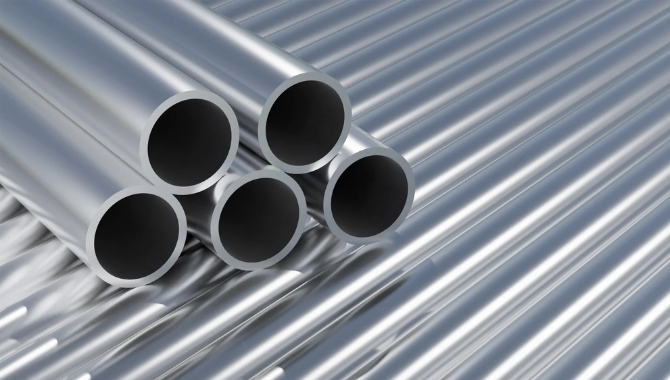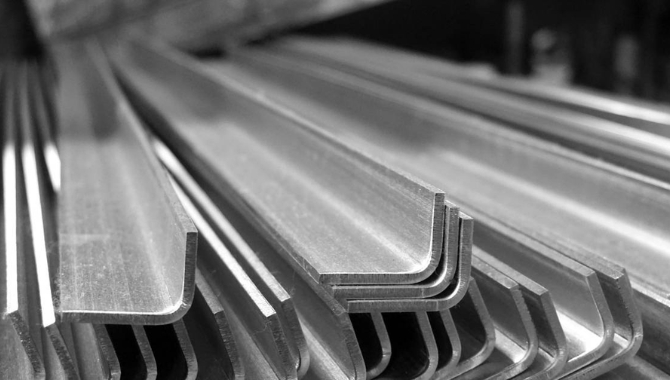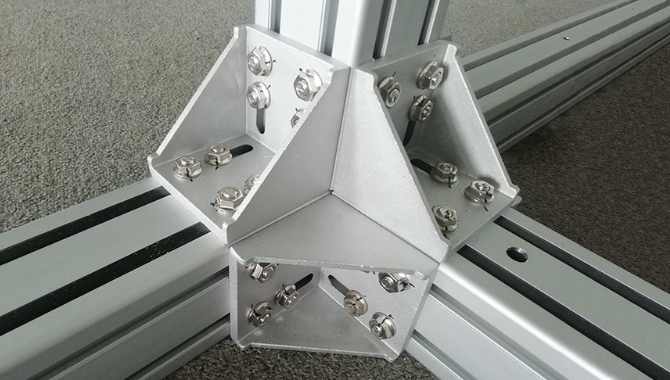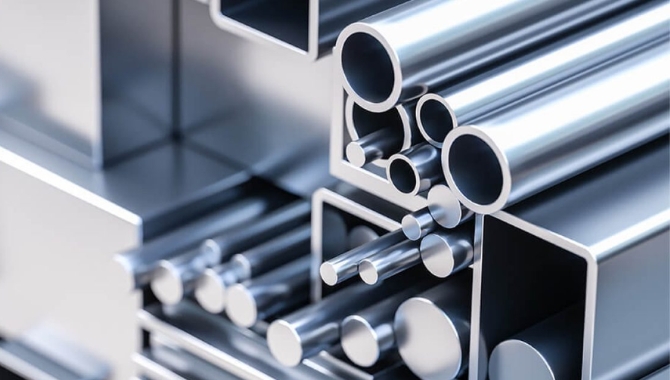Aluminum is one of the most used metals globally. But Why? It comes down to the special mix of characteristics it has. Weather it is the outstanding corrosion resistance or its light weight nature, aluminum gives an extraordinary package of benefits. Today we will see some of its properties more closely.
Physical Properties of Aluminum

Aluminum has many useful physical properties that make it the best for countless applications. From being lightweight to conducting electricity remarkably, this section looks at the key traits that determine how aluminum physically acts.
Density
With a density of only 2.7g/cm³, aluminum weighs about one third of steel (7.85 g/cm3). This light weight gives aluminum a big advantage in applications where minimizing mass is important like in cars and aerospace. Despite having low weight, aluminum still has an incredible strength-to-weight ratio which allow sturdy structural integrity in lightweight designs.
Electrical and Thermal Conductivity
Aluminum shines when it comes to conducting heat and electricity. With an electrical conductivity of 37.7 × 10^6 S/m at 20°C, it’s about 61% as conductive as copper that is the most conductive metal. This makes aluminum a great choice for electrical uses like power connectors and lines.
The thermal conductivity of aluminum which is around 237 W/mK is roughly 60% of copper’s. These qualities make aluminum the best affordable alternative to copper for heat sinks in power lines and electronics. It brings much of copper’s conductivity at a lower cost.
Reflectivity and Corrosion Resistance
When we talk about reflectivity, aluminum outshines others. It bounces back about 90% of infrared radiation and 80% of visible light hitting its surface. It also reflects lots of heat. This high reflectivity which is second only to silver, makes aluminum best for uses needing successful light and heat management. That’s why it gets used in solar reflectors, lighting fixtures and energy-efficient cool roofs.
Aluminum corrosion resistance comes from its property to form a protective and thin oxide layer when it comes in contact with air. This self-protecting 4 nanometer barrier puts a stop to corrosion and oxidation even in harsh industrial settings. Anodizing treatments can increase the durability and oxide layer’s thickness for more toughness under demanding conditions.
Ductility and Malleability
Of all metals, aluminum shines for its extraordinary formability. As the sixth most ductile and second most malleable metal, it can be drawn into wires or flattened into sheets as thin as 0.007 mm without cracking. This amazing flexibility comes from aluminum’s face-centered cubic crystal structure that enables its atoms to slide easily when stressed.
These qualities make aluminum perfect for many uses. From the thin walls of drink cans to complicated architectural designs, aluminum’s ability for forming and shaping open up endless possibilities for its use in many sectors.
Surface Finish and Appearance
Aluminum’s natural bright silvery sheen is because of its oxide layer. But you can change how it looks and make it more durable using different chemical and mechanical treatments.
Mechanical processes like polishing, brushing or sandblasting make varied levels of reflectiveness and textures. For example, polishing can achieve a 95% reflective mirror finish. Chemical treatments open up even more possibilities.
Anodizing is one of the chemical treatment that boost the properties of aluminum. It not only makes a spectrum of colors but also makes a wear-resistant and hard surface that resists abrasion and scratching. These customizable finishes have made aluminum perfect option for decorative uses in cars, architecture and consumer goods.
Chemical Properties of Aluminum

At the atomic level, aluminum shows some interesting chemical behaviors that lead to its widespread use. We will start by looking at its electronic structure then move on to compounds it forms and its reactivity patterns.
Oxidation Behavior
When exposed to air, aluminium promptly develops a protective, thin oxide coating. This Al2O3 layer is usually 2-3 nanometers thick. While amorphous in structure, this coating gives outstanding corrosion resistance. Its Pilling-Bedworth ratio of 1.28 shows that it sticks well to the aluminum surface. If the layer gets damaged, it can self-heal to keep good protection against further oxidation.
Acid and Base Reactions
Aluminum reacts with both acids and bases thus show amphoteric behavior. Acidic solutions lead to Al3+ ions forming and basic solutions produce [Al(OH)4]- ions instead.
When aluminum mixes with hydrochloric acid, the following reaction happen:
2Al(s) + 6HCl(aq) → 2AlCl3(aq) + 3H2(g)
The reaction rate speeds up with higher temperature and acid concentration. At 30°C in 1M HCl, aluminum usually dissolves around 0.1mm/year.
Alkaline solutions cause aluminum to form aluminates and hydrogen gas. For example, with sodium hydroxide:
2Al(s) + 2NaOH(aq) + 6H2O(l) → 2NaAl(OH)4 + 3H2(g)
This reaction is useful in aluminum etching processes.
Alloy Formation and Intermetallic Phases
Aluminum easily forms alloys with many elements which adds to its attributes. Usual alloying elements are silicon, copper, manganese, zinc and magnesium. These combinations bring better hardness, strength and corrosion protection versus pure aluminum.
When alloying, intermetallic phases like Al2Cu (θ-phase), Al3Mg2, and Mg2Si can grow which change the material’s qualities. Heat treatment methods like aging and solutionizing control the development and spread of these phases. This permits tuning the alloy’s properties for particular uses. These intermetallic phases mostly raise strength but they decrease the metal’s ductility.
Mechanical Properties of Aluminum

The mechanical properties of aluminum are traits that make this metal a powerhouse in engineering uses. Let’s look at some of the most important mechanical properties of aluminum.
Strength-to-Weight Ratio
The high strength-to-weight ratio is one of the most useful features of aluminum. Pure aluminum has around 90 MPa tensile strength but alloying can increase this to over 690 MPa for some heat-treated alloys. Along with aluminum’s low density of 2.7 g/cm3 this strength gives it a remarkable strength-to-weight ratio.
Automotive and aerospace industries particularly benefit from this property. The 2024-T3 aluminum alloy, for example, has a specific strength of 137 kN·m/kg which outperforms many steels. As a result, manufacturers can build lightweight structures without losing strength that will result in better fuel efficiency in planes and vehicles.
Tensile Strength and Hardness
While pure aluminum has comparatively low tensile strength (around 90 MPa) and hardness (about 15 HB on the Brinell scale) heat treatment and adding other elements can greatly increase these attributes. Blending in metals like magnesium, copper, silicon and zinc makes aluminum alloys harder and stronger.
A good example is the 7075 aluminum alloy. With zinc as its main added element it reaches Brinell hardness of 150 and a tensile strength of up to 572 MPa. These properties make it a good option for high-stress uses in auto and aerospace.
Further maximization of mechanical properties happens through heat treatment processes like aging and solution treatment. For example, the 6061-T6 alloy goes through these steps. And after the steps, it has a tensile strength of 310 MPa and a Brinell hardness of 95. Properties like these make it perfect for structural applications.
Fatigue Resistance and Durability
Unlike steel, aluminum doesn’t have a true endurance limit. So it can fail from repeated loading even at stresses under its yield point. But choosing the right processing and alloys can really boost how it resists fatigue.
Alloys like 7075 and 2024 show better fatigue resistance than weaker types of aluminum. For example, 2024-T3 has around 138 MPa of fatigue strength at 500 million cycles. 6061-T6 reaches about 96 MPa at the same cycles. Surface treatments like cold rolling and shot peening produce compressive residual stresses inside. This might make fatigue life 25 times longer.
Wear and Impact Resistance
Aluminum’s natural softness means lower wear resistance versus harder metals like steel. But specific treatments and alloy can really boost performance here.
Adding silicon in alloys like A380 and A356 makes wear-resistant, hard particles which in result increases durability. Anodizing also makes an abrasion-resistant, hard oxide layer which further aids in wear resistance. Hard anodizing can reach up to 65-70 HRC surface hardness that is best for high wear resistance applications.
Impact resistance of aluminum rely on the temper and alloy. Usually, alloys with higher ductility like 6061 and 5052 outperform super strong but less ductile alloys like 2024 and 7075 in impact resistance. Heat treatment also plays a role and T4 and T6 tempers balance toughness and strength.
Applications of Aluminum Based on Its Properties

Aluminum’s special properties are used in all kinds of products from airplanes to food packaging. This part explores different industries and shows how these sectors use aluminum’s traits to create new parts and solve issues.
Aerospace
Aluminum’s extraordinary corrosion resistance, light weight and spectacular strength-to-weight ratio made it a very important material in aerospace.
Airframes: Aircraft makers widely use 2xxx and 7xxx series aluminum alloys for building wings, fuselages and other structural components. These alloys deliver needed durability and strength along with minimizing aircraft weight. This gives higher payload capacity and better fuel efficiency.
Space structures: When it comes to space applications, aluminum shines because of maintaining strength at very low temperatures. Spacecraft designers like alloys such as 2195 and 2219 for building spacecraft structures, rocket fuel tanks and even the parts of International Space Station.
Automotive
In auto industry, aluminum’s lightweight yet strong properties greatly help cut emissions and boost fuel efficiency.
Engine blocks: A319 and A356 aluminum alloys are now the default options for making engine blocks. These alloys are very good at conducting heat that is critical for engines to disperse heat successfully. Compared to old cast iron blocks, aluminum engine blocks can halve the weight.
Body panels: For external panels, 6022 aluminum is mostly picked as it give extraordinary strength and formability after paint baking. Inner panels usually use 5182 aluminum as it can easily produce difficult shapes. By choosing aluminum instead of steel for body panels, 40-50% weight saving is possible which can bring big gains in fuel efficiency.
Construction and Architecture
Architects and builders like using aluminum for its durability, flexibility and attractive look. This handy metal shows up in lots of construction projects.
Curtain walls: Curtain walls largely use extruded aluminum mostly made from 6063 alloy. These parts create lightweight, sturdy structures for glass panels. And these panels make energy-efficient, modern facades that maximize natural light while resisting weather stresses.
Roofing and cladding: For exterior walls and roofing, 3105 and 3003 aluminum alloys perform exceptionally well. Their ease of molding, corrosion resistance and weatherproofing make them the best choice. Designers can shape these alloys into many aesthetically good profiles which also give long-lasting protection from the elements.
Electronics and Electrical
Aluminum’s traits are very important for the electrical and electronics industries. Its lightweight nature, conductivity, and resistance to corrosion make it a top choice for many uses.
Electrical wiring: Overhead power lines often have aluminum wires. Compared to copper, aluminum wire with 50% more cross section can handle the same current while weighing half as copper. This greatly cuts down on the load on support structures.
Heat sinks: Heat sinks in electronic equipments commonly use aluminum. Its easy extrusion and extraordinary thermal conductivity let it transfer heat away from delicate parts like transformer tanks and semiconductors. This prevents overheating so sensitive electronics can work as intended.
Packaging
The food and pharmaceutical sectors depend greatly on aluminum for packaging because it has barrier abilities, is non-toxic and recyclable.
Beverage cans: Beverage cans made from aluminum present three important benefits: they’re durable, lightweight and they successfully block moisture, light and oxygen. These qualities make sure drinks stay flavorful and fresh while decreasing shipping costs. Aluminum cans can be recycled indefinitely and therefor aluminum is an eco-friendly pick.
Foil packaging: For food storage, aluminum foil is very important. Its capability to stop bacteria, light and moisture renders it best for preserving and wrapping foods. The same protective quality applies in pharmaceuticals where aluminium foils safeguards delicate medications from possibly harmful environmental factors.
Beauty packaging: Aluminum is ideal for beauty packaging because of its aesthetics, light weight, durability, excellent barrier properties and recyclability. These properties not only enhance the functionality of the product, but also the visual appeal.
Conclusion

Aluminum possess a special combination of properties like high strength-to-weight ratio, low weight, good corrosion protection and many more. These traits make aluminum a very important material for many industries from construction to autos.
Do you want to get custom machined aluminium parts and benefit from the outstanding properties of Aluminum? KDM fabrication got you covered. Contact us now to discuss your project’s distinct requirements.
FAQs
What are the primary factors that influence the mechanical properties of aluminum alloys?
The main things that affects aluminum alloy’s mechanical properties are processing techniques, alloying metals and heat treatment. These decide what will be the precipitation hardening, grain arrangement and dislocation motion which will finally determine the ductility, strength and hardness of aluminum.
Is aluminum stronger than steel?
No, aluminum is usually not stronger than steel. Steel in general has greater hardness and tensile strength. But, aluminum’s strength-to-weight ratio mostly beats steel and makes it better for some uses.




